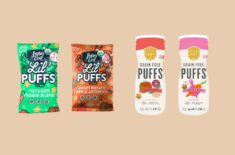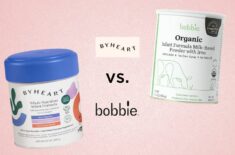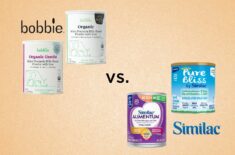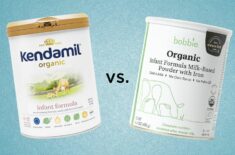Is Baby-Led Weaning Really Better?
Is your child ready to start on solid foods, but you’re unsure if baby-led weaning (BLW) is a safe feeding approach? That’s understandable. As parents, we are focused on our kids’ safety and health above all else.
Choking is among the leading causes of unintentional deaths in children under five years old. Around 12,000 children are rushed to the ER each year due to choking in the US. (1)
So, it’s easy to worry about the safety of finger foods and possible choking in baby-led weaning. You might even be wondering whether spoon-feeding can be the better option for your child’s safety.
But studies show that the frequency and risk of choking can be the same for both feeding methods. (2)(3)
Surprisingly, studies also show that as many as 52% of infants might have received food considered a choking hazard at seven months old. This figure applies to BLW and spoon-fed infants alike. (3)
Even though parents were informed about choking and choking hazards, many still gave some foods that can be choking hazards to their babies.
The number jumps to 94% in infants 12 months old and above. (3)
So, it’s important to know more about safety guidelines in feeding your child, no matter what feeding approach you choose. That way, you can help prevent choking incidents at home.
Should I Do Baby-Led Weaning Or Purées?
BLW (baby-led weaning) and traditional weaning with purées have their advantages and disadvantages.
Choosing BLW
Created by Dr. Gill Rapley, BLW promotes self-feeding with finger foods. This feeding approach focuses on having your baby take control of their feeding, allowing them to eat solids at their own pace. (4)
They’re also the ones who decide what food they’ll eat from the ones you prepare.
BLW can have many benefits, including possibly preventing your child from obesity or becoming a picky eater. Another benefit is improving fine motor skills. Your child also gets to join family meals. (4)
But it can also be quite messy. Still, if you’re prepared to handle the mess in favor of its many possible benefits, then you can give BLW a go.
Just ensure your child stays in their high chair for their safety and to help keep the mess in one spot.
Choosing Purées
We’ve already mentioned that there may be no significant difference in the number of choking incidents between these feeding methods.
But if you’d rather stay on the safer side and give purées as your child’s first foods, then you can choose traditional spoon-feeding.
However, your child gets to try fewer food varieties in the first few months of traditional feeding because you only give them purées at this stage.
Is Baby-Led Weaning Dangerous? Studies & Evidence
Studies show that the frequency and risk of choking can be the same for both BLW and traditional spoon-feeding. (2)(3)
Do Doctors Recommend Baby-Led Weaning?
Healthcare professionals are divided over the safety of baby-led weaning, though many agree that it can have plenty of benefits. (5)(6)(7)
Pediatricians’ Perspective
Arizona-based physician Dr. Wendi Carlton recommends BLW for its many benefits, including promoting healthy eating habits. (5)
She explains:
“You give them a chance to have food in front of them that they can touch, feel, smell, and know the texture in their mouths. Some kids have texture aversions growing up and this may be because you’re not letting them experience textures on their own early enough.” (5)
Dr. Carlton also explained that while BLW might cause more gagging when babies are still learning to eat, they gag less as they get used to the process.
She says that it could be because, by the time they’re used to eating at around eight months, BLW babies might already learn that if they shove the food in the back of their throat, it will make them gag. (5)
Dr. Carlton also believes that the choking incidents in BLW might have been due to parents giving their children “the wrong food.”
“The foods have to be a certain size — as big as their fist — so they can hold onto it.
Parents who notice choking may have given their babies something like small candies, nuts, or raisins.” (5)
She advises parents to talk to their pediatricians before starting BLW. She also recommends picking safe foods for their babies and watching them during mealtimes.
Another pediatrician, Ohio-based Dr. Kimberly Churbock of Cleveland Clinic, also recommends BLW. She points out that BLW can have many benefits for your child, but it’s important to practice safety at all times. (8)
She explains:
“You’re incorporating baby into family mealtime from the get-go, allowing your baby to eat some of the same foods that the rest of the family is eating, but being mindful of portions for your littlest eater, and what is going to be safe and appropriate for them.”
Dr. Churbock believes that these can be some of the benefits of BLW:
- BLW babies can enjoy valuable social interactions by sharing family mealtimes.
- They can also have a role model in chewing and swallowing food.
- Your baby can enjoy more diverse foods.
- They get to explore a broader range of tastes and try new textures earlier in life.
- They get to develop their oral motor and fine motor skills.
- They can learn to self-regulate over time because they’re more in control of what’s going on in their mouth.
Like Dr. Carlton, she also recommends consulting your pediatrician for questions or concerns about BLW.
She advises parents to continue breastfeeding or formula-feeding throughout their first year of life.
Studies On Doctors’ Recommendations
Some studies show that over 50% might not recommend the feeding method due to concerns over suffocation and choking. (6)(9)
Most mothers who tried BLW in these studies recommend the feeding approach. (6)(7)(9)
Many of these moms apparently learned about BLW through social media and blogs because doctors in their area said they aren’t likely to support it in practice. (7)(9)
Surprisingly, despite claiming that they might not recommend BLW, the healthcare professionals in these studies acknowledged its possible benefits. (6)
For example, a study shows that over 80% of pediatricians might acknowledge that BLW can promote the following: (6)(7)(9)
- Fine motor skills
- Oral development
- Fewer mealtime battles
- A greater opportunity to share family meals
- Healthier eating habits
- Possible developmental advantages
- Convenience
Still, around 48.5% of these healthcare professionals remain cautious about recommending it to new parents even knowing these possible benefits. (7)(9)
BLISS Study: Does BLW Increase Choking?
The 2016 BLISS study released by the AAP (American Academy of Pediatrics) evaluated the safety of baby-led weaning compared with using purées in traditional weaning. (3)
The 206 infants in the study were grouped into two: control (traditional weaning) and BLW.
Before evaluating the babies, the researchers taught caregivers and parents about the safety practices in baby-led weaning.
The study didn’t find any significant differences in the number of choking events between the two groups (BLW vs. spoon-fed infants). (3)
Surprisingly, however, the researchers observed three alarming outcomes.
Despite prior education on safety practices in eating solid foods, the caregivers or parents in both groups reported that:
- The babies were offered foods that could pose a choking risk.
- They didn’t closely supervise the babies while eating.
- Many of the children may have experienced at least one serious choking episode (3)
As many as 52% of seven-month-old babies and 94% of 12-month-old toddlers might have received foods considered as choking hazards in both groups. (3)
The number of choking incidents was also high (35%) for babies between six and eight months of age.
The researchers expressed that it’s “concerning” to have such a large number of choking incidents in both feeding groups.
Though the study shows that baby-led weaning may not cause an increased risk of choking, both feeding methods can have potential safety risks.
The researchers recommend addressing these issues to ensure infant safety for both feeding methods. (3)
As parents, we must remember to closely supervise our children during meals to help avoid possible choking incidents.
Comparative Study On Feeding Methods (2018)
A 2018 comparative study involving 1,151 mothers with babies ages 4-12 months also showed similar results to the BLISS study. (2)
The researchers collected data from three groups:
- Strict BLW
- ‘Loose’ BLW or mixed approach
- Traditional weaning method
The study showed that, generally, infants following BLW might have the same choking risk as spoon-fed babies. (2)
Surprisingly, the study found a lower choking rate (13.6%) than the BLISS study (35%). (2)(3)
But they also had another discovery: more spoon-fed babies may have choked on finger foods and lumpy purées than strict BLW or loose-BLW infants. It might be because they weren’t as used to eating finger foods as these other groups. (2)
What Are Two Dangers Of Baby-Led Weaning?
Concern #1: Baby Not Getting Key Nutrients
You might have read blogs about baby-led weaning being bad for child health because it reportedly can’t give them the necessary nutrients for proper growth and development.
But studies show that this might not be the case. Babies can get important nutrients from foods in baby-led weaning. (10)
However, it’s worth noting that babies might also be exposed to unhealthy foods while sharing family meals in BLW.
A literature review on baby-led weaning didn’t just focus on choking. It also compared nutrition issues (foods offered and nutrient or energy intake), eating behavior, and impact on children’s weight. (10)
The study had surprising results.
Nutrient Intake
According to the literature review, BLW infants may be more likely to consume meat and cow’s milk or dairy products. But they can also be more prone to an early introduction to sweet foods. (10)
What’s surprising is that the study also discovered that BLW infants might be more likely to consume powdered infant cereals than spoon-fed infants. Parents of the traditional feeding group may be more likely to pick ready-to-eat commercial infant foods. (10)
BLW is often linked to concerns about low-iron consumption. Yet studies show that these babies might actually be more likely to meet their nutrient needs because of possible iron-rich meat consumption at a younger age. (3)(10)
Foods Offered
Different families can have varied ways of offering their babies a variety of foods in baby-led weaning. Many prefer providing veggies like sweet potato or fruits like avocado.
But studies show that many parents might not be following the principles of BLW. (10)
Some parents modify their family’s diet to fit their baby’s needs, such as choosing more healthy foods and less sodium. But many babies may have been introduced to high-sodium foods while sharing meals with the family. (10)(11)
Concern #2: Baby Isn’t Eating Enough Solid Foods
Energy Intake
Although it can be difficult to measure food intake in BLW babies, studies show that there might be no significant difference between the energy intakes of babies from the different feeding groups. (10)(11)
Dr. Rapley’s Thoughts
Dr. Rapley reminds us that BLW allows children to eat what and how much they need. (12)
If your baby isn’t eating as much as you want them to, then perhaps you just wanted to make them eat more than what they actually need. She says it’s not a feeding failure.
Dr. Rapley explains: (12)
“A normally developing, healthy baby who appears to be ‘not eating well’ is probably just eating less than his parents or others think he should.
In the second half of their first year the only nutrients most babies begin to need in addition to breastmilk are tiny amounts of iron and zinc.
A few licks or bites (not mouthfuls!) each day from foods rich in these minerals, such as meat and eggs, is almost certainly enough to provide this.
Babies don’t starve themselves – if they are hungry, they will eat.
The problem is that our expectations of how much babies should eat tends to be based on the amounts they eat when they’re spoon fed.”
But if you’re really concerned that your child is a ‘poor eater,’ the BLW pioneer recommends the following: (11)
- Continue breastfeeding or providing formula to your baby to meet their nutritional needs.
- Continue giving your baby opportunities to explore and taste a wide variety of foods.
- Try offering smaller pieces (but watch out for choking hazards) or baby-safe cutlery because they might just be bored with their feeding routine.
- Don’t make a fuss if your child doesn’t like something. You can even offer them other food options instead.
- Don’t keep picking up and returning foods they throw out of their tray.
- Try to understand your baby’s behavior. If they keep throwing food to the floor, it might signify that they aren’t hungry, or perhaps they want a different kind of food.
Safety Considerations In Baby-Led Weaning
Gagging Vs. Choking in BLW
Did you know that kids are born with a strong gag reflex that can help keep them from choking? (13)
It diminishes at around six months of age or around the time they’re ready for solid foods.
Gagging is a normal reflex action that you shouldn’t try to stop. “Helping” your baby when they’re gagging can actually be dangerous and lead to choking. (13)
But choking is dangerous. It happens when your child’s airway is blocked. It’s important to immediately remove the blockage because it can stop your baby from breathing.
That’s why it’s essential to learn the difference between gagging and choking, so you’ll know how to act depending on the situation.
Many parents might also prefer to learn baby first aid procedures for their peace of mind when emergencies happen.
Reducing Choking Hazards
Any feeding method can potentially cause choking if pieces of food block your child’s airway. You can help keep them safe by avoiding these common choking hazards:
- Tough chunks of meat
- Hard meat products like hot dogs and sausages
- Hard, raw vegetables like carrots
- Hard fruits like raw apples
- Whole foods or small, round fruits like whole grapes
- Whole nuts or thick nut butters
Baby Led Weaning Caution For Some Babies
BLW isn’t for everyone. Some parents still prefer purées and traditional weaning.
Still, this feeding approach might also be unsafe or not ideal for babies who aren’t developmentally ready and those with certain medical conditions.
BLW encourages offering your child finger foods, so babies have to meet certain developmental milestones so they can do it safely. Physical skills like sitting up, chewing, and swallowing are also important.
Check with your little one’s pediatrician before introducing solid foods if your child:
- Is younger than six months of age
- Has a cleft lip or palate because these might physically make it more difficult for them to take a bite, chew, or swallow their food (14)
- Has hypotonia, a condition that causes low muscle tone for the tongue, lips, or jaw, so it can be hard for your kid to manage the food in their mouth (15)
- Has an unresolved tongue or lip tie because babies need easily move food using their tongue (16)
Readiness & Allergen Safety
Most 6-month-old babies can be ready for solid foods. But this age isn’t absolute: some babies may develop earlier or later than others.
What’s important is that your child shows signs of readiness before you start giving them solid foods.
But readiness isn’t the only thing to consider in ensuring that your baby is safe in BLW. You can learn more about it, plus the benefits of baby-led weaning and other important safety guidelines in this comprehensive BLW guide.
You can also find tips on allergen safety and how to prepare baby foods (large vs. small pieces) to reduce choking risks in our handy guide.
REFERENCES
(1) https://www.health.ny.gov/prevention/injury_prevention/choking_prevention_for_children.htm
(2) https://pubmed.ncbi.nlm.nih.gov/29205569/
(3) https://pubmed.ncbi.nlm.nih.gov/27647715/
(4) http://www.rapleyweaning.com/assets/Defining_BLW_v2.pdf
(5) https://www.dignityhealth.org/articles/baby-led-weaning-the-facts-behind-the-fad
(6) https://pubmed.ncbi.nlm.nih.gov/23183112/
(7) https://www.ncbi.nlm.nih.gov/pmc/articles/PMC6202902/
(8) https://health.clevelandclinic.org/baby-led-weaning/
(9) https://pubmed.ncbi.nlm.nih.gov/26771760/
(10) https://pubmed.ncbi.nlm.nih.gov/28596930/
(11) https://pubmed.ncbi.nlm.nih.gov/27154478/
(12) http://www.rapleyweaning.com/assets/My_baby_isn’t_a_good_eater.pdf
(13) https://www.rch.org.au/feedingdifficulties/casescenarios/Ava/
(14) https://www.mayoclinic.org/diseases-conditions/cleft-palate/symptoms-causes/syc-20370985
(15) https://www.childrenshospital.org/conditions-and-treatments/conditions/m/muscle-weakness-hypotonia
(16) https://www.mayoclinic.org/diseases-conditions/tongue-tie/symptoms-causes/syc-20378452












